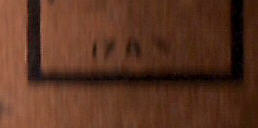American Can Company Dating Codes, 1935-1953
From 1935 through 1953 American Can Company (CanCo) placed a tiny code along the bottom edge of the cans that they made. The code indicated both the city where the can was made, and the year. Discovered by collector Bob Porter, this dating code has been exceptionally useful in deciphering the history of certain beer can labels and brands. It is reproduced here with his permission.
The code appears along the bottom edge of the can. Here's an example from a Ballantine Ale can. It's very small. Can you see it on this photo? It is just to the left of the word "TRADE."
 |
Here is a (fuzzy, sorry) close up.
 |
This example reads "17 A \". So, what does this mean? (Answer at the bottom of the page)
The code often follows a particular pattern. A.C. CO [##] A [small symbol] The "A.C. CO" stands for American Can Company.
This may also appear as "AMER. CAN CO. [##] A [small symbol] on later cans. See the second example at the bottom of the page.
On some cans the pattern is shorter, a simple [##] A [small symbol] as in the example above.
The 2 digit number following indicates in which city the can was made (American Can had numerous plants around the US). The codes are as follows.
10 - Greenwich, CT |
17 - Philadelphia, PA |
23 - Baltimore, MD |
34 - Pittsburgh, PA |
38 - Buffalo, NY |
44 - New York City, NY |
47 - Atlanta, GA |
50 - Cleveland, OH |
68 - Chicago, IL |
70 - St. Louis, MO |
83 - Omaha, NE |
90 - Salem, OR |
91 - Los Angeles, CA |
94 - San Francisco, CA |
98 - Sacramento, CA |
After the can company code is an "A" or an "A-" followed by a symbol. The "A" may stand for "American Can" but this has not been confirmed.
The final tiny symbol after the "A" indicates the calendar year in which the printed sheet of beer cans was made. This does not mean the can was filled that year. Breweries might buy a large lot of cans then fill them later. This is especially true if the brand being filled was not very popular or was a seasonal beer such as a Bock. For example, Krueger Brewing canned Kent Ale in the 1930s. It was not a big seller so they apparently only canned it irregularly. As a result, a Kent Ale can may have been filled a couple of years after the can was manufactured. However, for most cans the date symbol will correspond fairly closely to when the can was actually filled and sold.
The following chart shows the canning code symbols with the year each was used.
| 1935 |  |
A simple "X" |
| 1936 |  |
The "X" now has left side closed |
| 1937 |  |
The "X" now has both sides closed, forming a "bow-tie" |
| 1938 |  |
Bow-tie with single dot top/middle |
| 1939 |  |
Bow-tie with two dots, top/middle and bottom/middle |
| 1940 |  |
Bow-tie with three dots |
| 1941 |  |
Single backslash |
| 1942 |  |
Double backslash |
| Beginning in May 1942 beer cans were limited to use by the military. Breweries could use what cans they still had in stock for civilian use. Civilian beer cans did not return until early 1947, so from mid-1942 until late-1946 you should only find these symbols on cans meant for military use. | ||
| 1943 |  |
Diamond |
| 1944 |  |
Diamond with a single dot in the middle |
| In 1945 and 1946 two different dating codes were used. | ||
| 1945a |  |
Diamond with one outside dot, top/left |
| 1945b |  |
Diamond with one outside dot, top/right. |
| 1946a |  |
Diamond with two outside dots, top left and right |
| 1946b |  |
Diamond with two outside dots, top and bottom right. |
| 1947 marks the return of cans available for civilian use. Some civilian use cans have the 1946 code. Presumably they were made ready for civilian canning to resume and filled in 1947. | ||
| 1947 |  |
Diamond with three outside dots |
| 1948 |  |
Diamond with four outside dots |
| 1949 |  |
Similar to the number "7" standing on its face. |
| 1950 |  |
Number "7" with inside dot |
| 1951 has two different dating codes. | ||
| 1951a |  |
Number "7" with inside diagonal. Looks somewhat like an arrow cursor. I do not see this one very often. |
| 1951b |  |
Number "7" with one leg, it resembles the Greek letter Pi. I see this one more often than the previous variation. |
| 1952 |  |
Greek Pi with two legs |
| 1953 |  |
Greek Pi symbol with three legs |
So the "17 A \" on the Ballantine pictured at top means the can was made at American Can's Philadelphia plant in 1941.
Here is another example, this time from a Krueger Beer.
 |
The code is 23-A followed by the 1953 code, so this can was made in 1953 at the Baltimore, Maryland facility.
One final note. The symbol is sometimes sloppily printed, so it can be helpful to compare the symbols on more than one example of the same can.
Thanks to Bob Porter for his help.
For more information on dating old beer cans check my "How Old is My Can?" page and Breweriana.com has a nice guide as well.
